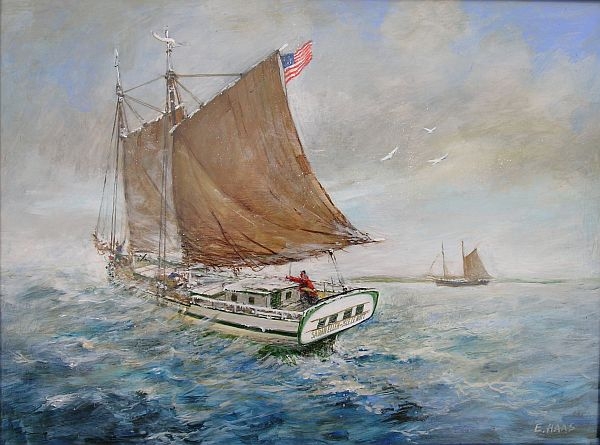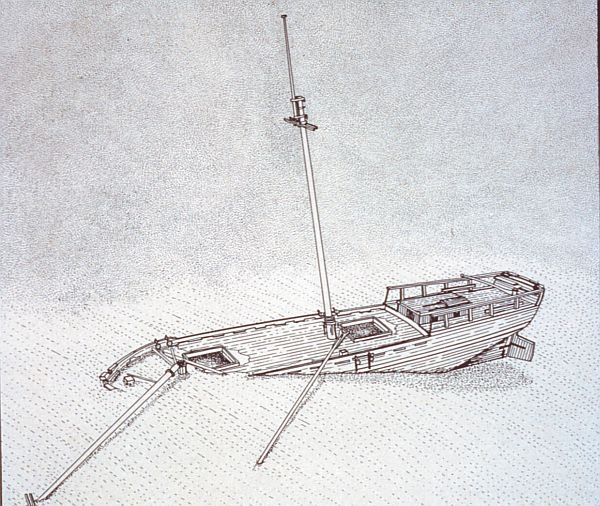 (HOST) In the Post-Revolutionary War period on Lake Champlain, sloops and canal schooners were among the first means of transporting people and goods in the area. The Sarah Ellen was a single deck, two-masted lake schooner. She was seventy-three feet long and fifteen and a half feet wide.
(HOST) In the Post-Revolutionary War period on Lake Champlain, sloops and canal schooners were among the first means of transporting people and goods in the area. The Sarah Ellen was a single deck, two-masted lake schooner. She was seventy-three feet long and fifteen and a half feet wide.
On December 19th, 1860 she and her companion schooner, The Daniel Webster left Willsboro, New York with a load of stone bound for Burlington. The Sarah Ellen never finished her journey. In the third part of our series, "History Under the Waves", the Lake Champlain Maritime Museum’s director, Art Cohn, describes her tragic fate.
Click here for the History Under the Waves photo gallery
(ART COHN) These two schooners, heavily laden with stone were crossing the lake from Willsboro to Burlington when they hit a gale. And then it’s speculated that the Sarah Ellen either sprung a plank, which would be catastrophic in a boat full of stone, or took water over the head in the bow, and began sinking by the head, by the bow. All the rigging, all the masts, all the exposed portions of this boat were iced up.

They did deploy their yawl boat, their small rescue boat. But it was so full of ice they couldn’t deploy it floating. They deployed it overturned, half loaded with ice. And so when the Sarah Ellen went down, we know from eye-witnesses on the other schooner’s deck what happened.
And that was that the three people aboard the Sarah Ellen – her twenty-one year-old captain, his brand new bride, just married that fall, Lucy Whitney from Burlington, and the one crewman later on identified as Joseph LaPlante all went into the water and were all seen hanging from the overturned lifeboat that was so full of ice that it could not actually accommodate them.
The Daniel Webster positioned itself to make a rescue. And so tacking in this gale, it attempted to run down on this life boat were the three people clung to life, hanging in this very cold water.
When they got up to the lifeboat, they were able to pull the Frenchman aboard. But the impact with the lifeboat sent Henry Clay, the captain and his bride, Lucy, flying. And they were not able to be retrieved.
They were seen floating on the water. They were seen with the captain, Henry Clay, attempting to support his wife above the water when she finally succumbed to the cold and the conditions and sank.
He was seen for a minute more before he disappeared beneath the water, as the Daniel Webster attempted to get back to him in time to make the rescue, which they could not do.
And so you have the tragic loss of this vessel and the more tragic loss of this young couple as they were attempting to make their way to Burlington.
We found the boat in 1989. We dove it with an ROV. We completely documented it. And this boat sits in the deepest reaches of Lake Champlain, over 300 feet of water. It’s this extraordinary three-dimensional wooden object. It looks like it just sank. It’s in such incredible cold storage. The caulking between the seams on the planking is absolutely perfect. You’d swear the boat had just arrived.

We know it contains 100% of the things that made this boat a working watercraft – woodstove and dishes and jugs and foodstuffs and utensils, and all the things that made this boat a live-aboard vessel, working on Lake Champlain, supporting the life of the people who were the life-blood of the economics of that time period will all be contained in this time capsule.
(Host) Tomorrow in our series we’ll hear about the wreck of the Champlain Two, a ship that represented the pinnacle of steamboating in 1875 when it went down. You can find more information on this series and others in our Champlain400 coverage at VPR.net.
Originally broadcast July 29, 2009 as part of VPR’s Champlain 400 coverage.